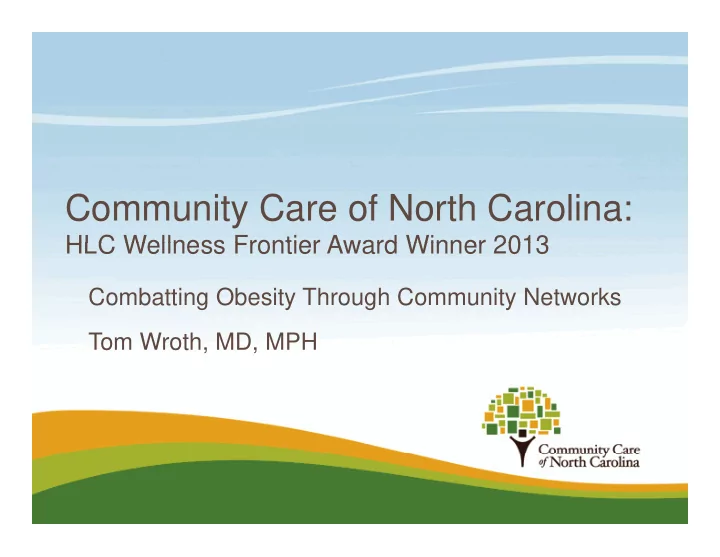

Community Care of North Carolina: HLC Wellness Frontier Award Winner 2013 HLC Wellness Frontier Award Winner 2013 Combatting Obesity Through Community Networks Tom Wroth, MD, MPH
National Model for What Works National Model for What Works Health informatics target at-risk Community-based, physician-led beneficiaries and high-impact care beneficiaries and high impact care medical homes coordinate care settings across health systems Use of data to drive performance Managed through 14 local, non- and standardization across profit networks ~ 1 800 practices profit networks, ~ 1,800 practices networks & 6,000+ providers Medicaid savings achieved in Population Health Approach: partnership with doctors, hospitals Case management and medical Case management and medical and other providers home capacity building Able to demonstrate improved Goal: Ensure patients receive quality and health outcomes and optimal care, avoid cost containment = value based t t i t l b d unnecessary utilization and model reduce costs 2
CCNC Regional Networks
CCNC Medical Home Population mgmt: t Stratify population, choose targets g Data to inform decisions & focus efforts Primary Care P i C Multi-disciplinary team: Foundation RX, Behavioral, Care Manager
CCNC Practice Network: 90% of Primary Care Providers in NC Large Health System Owned Practices Other Hospital Owned Practices 5
CCNC HEDIS Performance Compared to Medicaid Managed Compared to Medicaid Managed Care Benchmarks >10,000 more North Carolinians with good diabetes control CCNC National HEDIS Mean for Medicaid Managed Care >11,000 more North Carolinians with Ca o a s t good blood pressure control Higher is better!
Peer-reviewed research Cuts Program Costs Cuts Program Costs Significant savings for 169,667 non-elderly, disabled Medicaid recipients $184 million savings $ g in about 5 years Higher per-person g p p savings for patients with multiple chronic conditions.
Medicaid Population Obesity and Diabetes by County: A1C A1C >9 and BMI >30 9 d BMI 30
CCNC Population Management Approach M t A h Practices/Communities People p Identify practices and Use data to identify communities with individuals who are high prevalence of high prevalence of ‘impactable’ impactable obesity Develop care plan and Coach practices on set patient centered incorporating goals evidence based care Refer patients with into their workflow obesity to obesity to Measure results and Dietician on care provide feedback management team Community resource or health coach
Improving Quality: Identifying Practices with Opportunities to Improve Improve Claims-derived measures; annual chart reviews chart reviews 12
Engage practice in g g p evidence based approach Use of motivational interviewing techniques techniques ‘Workflow Friendly’
CCNC Pediatric Quality C ll b Collaborative (26 Practices) ti (26 P ti )
Lessons Learned from N North Carolina h C li It takes a village It takes a village Patient engagement is the new bl blockbuster drug kb t d Cross silo work is essential You get what you pay for 15
Recommend
More recommend